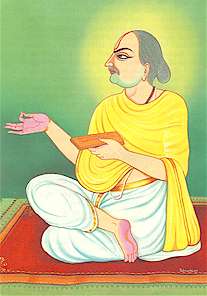| Home |
| Subscribe |
| Contact |
|
|

Photo courtesy of Bhajana Sampradaya.
Click here for more information.
Vallabhaacaarya - (1479-1531) A great 16th century sage-philosopher of India, he is the founder of the Vaishnavite sect in Rajasthan and Gujarat. he came from a Telugu Brahmin family (contemporaries of Chaitanya Mahaprabhu) in Champaranya, Raipur, Madhya Pradesh, the son of Lakshmana Bhatta and Ilamma. It is said that the family had finished performing 100 Soma Yagas (sacrifices) and hence the Lord Agni (Lord of Fire) was born to them as a son on the way when they went to Kasi to feed 100,000 Brahmins.
Vallabha's father died when he was 11, and he completed his studies of scripture at Kasi at 12 years under Madhavendra. He married Mahalakshmi at Varanasi at 28 and bore two sons. From there, he went to Vijayanagar, where he won the patronage and respect of Krishna Deva Raya, the ruler there. It was the King who gave him the title "Vaishnavacharya." Vallabhacharya was generous and distributed the wealth the King gave him among the court. The now great sage moved on to Ujjain and then Mathura and Brindavan, where he worshipped Krishna devotedly.
Once he saw a man worshipping both an image of God and a saligrama (a sacred stone in which Lord Vishnu is said to reside). That man believed that the saligrama was superior to the other images. Vallabhacharya tried to correct him by saying all forms of God are equal, but the man placed the Saligrama on top of the idol and went to sleep. In the morning, when he opened the puja-box, he saw the saligrama broken to pieces. The man apologized to Vallabhacharya, who advised him to wash the pieces with the abhisheka water and repair the saligrama. After washing it, it was whole again!
Vallabhacharya spent his last days in Kasi. At the age of 52, he went to the Hanuman Ghat to bathe. After his bath, people saw him going up to heaven direct with his body shining like the Sun. Today, a temple stands at the ghat, dedicated to him. His followers in North India are called Goswamis and call his path of worship Pushti Marga, or the Divine Path of Grace, which follows the Shuddhadvaita school of philosophy.
Many of his pieces involve praise of Lord Krishna, especially in the form of a boy. Some works include Vyasa Sutra Bhashya, Jaimini Sutra Bhasya, Bhagavata Tika Subodhini, Pushti Pravala Maryada and Siddhanta Rahasya, all in Sanskrit. Vallabha has written many books in Brij Bhasha as well.
Mudra:
Compositions:

